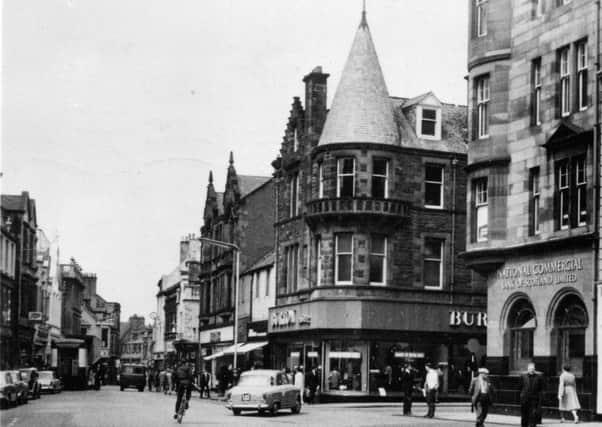A stroll along the High Street of the 50s


I could have popped into the Gaff Inn, the Steeple Bar or the Blue Bell but one is enough for today.
If we are lucky we might catch King Kenny entertaining the shoppers with his battered banjo or hear George Washington, in bowler hat and white silk scarf, urge us to repent our sins before he pops round to the Commercial for a dram or two.
Advertisement
Hide AdAdvertisement
Hide AdA visit to Mr Gibb’s little model shop is a favourite treat for many a child but adults might prefer a quick diversion along narrow Wooer Street to Harry Kirk’s gramophone record shop or even his next door neighbour where strange looking gentlemen’s trusses and other medical equipment fill the window.
Best to give the pawn shop across the street the go-by though a bowl of ‘potted heid’ from Clarke’s Home Bakery would be a treat worth taking home.
Back to the High Street and the clothing centre of the town where gents can find a suit at Alexandre’s or follow the advice of the TV ads and watch John Collier’s window!
Montague Burton took over the old Railway Hotel building in 1924 and the firm are still in business today.
Advertisement
Hide AdAdvertisement
Hide AdFor the ladies, Zuill and Stewart, ‘Falkirk’s centre of fashion since the year 1897’, is the place to visit. Boots stands there today but back then they occupied a different place further down the street.
Falkirk’s most popular tobacconist, Clarkson’s, is still thriving here in the pre anti-smoking age in the busiest part of town where shoppers fill the street and cars have to crawl through a narrow gap in the crowds.
Here are the big department stores F W Woolworth and Marks & Spencer as well as Mathieson’s celebrated bakery and tea rooms.
Across the road we can visit Horne’s fruit and veg shop, Gordon Drummond’s chemists (established in 1785) with its mortar and pestle sign, Nairn’s large furniture store and Hepworth’s clothiers.
Advertisement
Hide AdAdvertisement
Hide AdFurther down the street stands the Parish Church and graveyard still crowded with ancient gravestones though well hidden behind the High Street buildings. It would not be too long before the official vandals of the day filled the dustbin of history with this precious part of our heritage. ‘In Loving Memory’ indeed!
We have reached the part of the street where, with similar disregard for the past, the 1960s planners and developers destroyed so much of our built heritage leaving us today with ugly square concrete and glass monstrosities where once there were closes, wynds and many small shops.
The Bank of Scotland and F & J McRae’s butchers were there and a few yards further on William Brown’s Swan Inn glowered over the road towards the Temperance Cafe, a genteel eating place free from the dreaded booze!
Marshall’s sweetie shop is not far away before we pass the rear entrance of the Gaumont picture house which had been the Pavilion not many years before.
Advertisement
Hide AdAdvertisement
Hide AdWilliam Gibson’s stationers is next, followed by the Royal Hotel and ending with the Royal Bank buildings facing down West Bridge Street.
Our shopping trip is nearly over now. A few small shops remain along the south side, Cooke’s bakery, Condie’s boot repairs and Pollock’s licensed grocers but we have had enough for today!
In the distance we catch sight of the haven that is the West End Cafe where an ice cream from Peter Moscardini is our last purchase of the day.